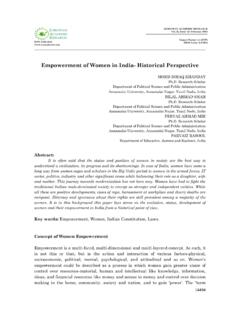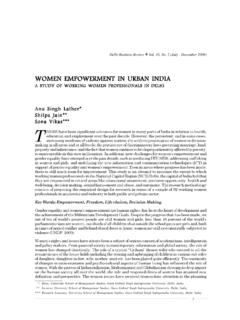Transcription of Women Empowerment: Dimensions, Needs and Hurdles in …
1 International Journal of Commerce and Management Research, Toll Free: 1800-1234-070 48 IMS Business School Presents Doctoral Colloquium 2017 ISBN: 978-93-85895-57-9 Women empowerment : Dimensions, Needs and Hurdles in India 1 Nabanita Dutta, 1 Kaushik Bhakta 1 Research Scholar, Department of Education, University of Calcutta, Kolkata, West Bengal, India Abstract For centuries Women were not treated equal to men in many ways. They did not have share in the property of their parents, they had no voting rights, and they had no freedom to choose their work or job and so on. Now that we have come out of those dark days of oppression of Women , there is a need for strong movement to fight for the rights of Women and to ensure that they get all the rights which men have or in other words a movement for the empowerment of Women .
2 The present paper has been planned with a view to discuss the various issues related to the empowerment of Women and to suggest measures for achieving this end. The purpose of the paper is to discuss the historical and sociological dimensions of the issue of Women empowerment , to know the role of education in Women empowerment , need for Women empowerment in modern context, measures for ensuring Women empowerment and to know about the Hurdles in achieving Women empowerment . Keywords: Women empowerment , Hurdles , Education 1. Introduction empowerment of Women is essentially the process of upliftment of economic, social and political status of Women , the traditionally underprivileged ones, in the society. It involves the building up of a society wherein in Women can breathe without the fear of oppression, exploitation, apprehension, discrimination and the general feeling of persecution which goes with being a woman in a traditionally male dominated structure.
3 The origins of the concept of empowerment go back to the civil rights movement in the USA in 1960. It has since then interpreted differently and filled with new meanings and is today used in such different sectors as business, social work, development discourse and by advocates of very different political agendas. The different definitions of empowerment range between defining it as a largely individual process of taking control and responsibility for one s life and situation, and defining it as a political process of granting human rights and social justice to disadvantaged group of people. At the former end of the continuum, where empowerment is defined largely as an individual process, empowerment can be used in the conservative political rhetoric of freeing the government of responsibility for injustices and for granting social security.
4 Instead, the argument makes individuals and communities responsible for their own social security and welfare, without providing the necessary support and resources. The empowerment of Women is located within the discourse and agenda of gender equality and is increasingly being taken in the agenda of international development of organisations, perhaps more as a means to achieve gender equality than as an end in itself. At the Social Summit in Copenhagen in 1993 and the International Conference on Population and Development in Cairo 1994 Government committed themselves to the empowerment of Women . This Commitment was operationalised and formulated into a clear action plan at the Fourth World Conference on Women in Beijing 1995 where Governments committed themselves to the empowerment and advancement of Women , including the right to freedom of thought, conscience, religion and belief, thus contributing to the moral, ethical, spiritual and intellectual Needs of Women and men, individually or in community with others and thereby guaranteeing them the possibility of realizing their full potential in society and shaping their lives in accordance with their own aspirations.
5 Different Levels of empowerment in line with most theorists on empowerment the one has to view empowerment as taking place on different levels and that change on all levels is necessary if the empowerment of Women is really to occur. We have to relate empowerment at three levels: empowerment on the individual, group, and societal/ community- level and the interaction between these. The individual level deals with individual Women s abilities to take control over their lives, their perceptions about their own value and abilities, their abilities to identify a goal and work towards this goal. The group level deals with the collective action and sense of agency that woman experience together, in a group. The societal level deals with the permissiveness of the political and social climate, the societal norms and the public discourse on what is possible and impossible for Women to do, how Women should behave etc.
6 The different levels are seen as interconnected and mutually reinforcing, when empowerment on individual level occurs, this will have effect on the group and societal level. Women who are empowered on an individual level will most likely go on and affect the other levels. empowerment on a group level Women organizing around a particular need is likely to have effect on the individual empowerment of Women in the form of increased self-esteem and sense of agency. Need and Significance of the study India is a country of grand contradictions. While it is a global leader in the knowledge economy, it is also home to more than half the world s poor and illiterate people, most of whom are Women (Reddi & Sinha, 2004). Indian Women are discriminated and marginalized at every level of the society whether it is social participation, political participation, economic participation, access to education, and also International Journal of Commerce and Management Research, Toll Free: 1800-1234-070 49 IMS Business School Presents Doctoral Colloquium 2017 ISBN: 978-93-85895-57-9 reproductive healthcare.
7 Women are found to be economically very poor all over the India. A few Women are engaged in services and other activities. So, they need economic power to stand on their own legs on a par with men. Other hand, it has been observed that Women are found to be less literate than men. According to 2001 census, rate of literacy among men in India is found to be 76% whereas it is only 54% among Women . Thus, increasing education among Women is of very important in empowering them. It has also noticed that some of Women are too weak to work. They consume less food but work more. Therefore, from the health point of view, Women folk who are to be weaker are to be made stronger. Another problem is that workplace harassment of Women . There are so many cases of rape, kidnapping of girl, dowry harassment, and so on.
8 For these reasons, they require empowerment of all kinds in order to protect themselves and to secure their purity and dignity. To sum up, Women empowerment cannot be possible unless Women come with and help to self-empower themselves. There is a need to formulate reducing feminized poverty, promoting education of Women , and prevention and elimination of violence against Women . Pandit Jawaharlal Nehru first Prime Minister of India once remarked, To awaken the people, it is Women who must be awaken; once she is on the move, the family moves, the village moves and the nation moves . So there is a greater need of bringing Women into mainstream of development of India. Objectives: The present study has the following objectives- Obj 1: To know the historical, sociological, economical and political dimensions of the issues of Women empowerment .
9 Obj 2: To know the Hurdles in achieving Women empowerment . Obj 3: To know the role of education in Women empowerment . Obj 4: To know the measures for ensuring Women empowerment . 2. Methodology This is a qualitative study. The investigators here collected data from different secondary sources like research journals, various government organizations, books, websites etc. Findings According to the objectives of the study findings of the study are discussed below- Obj 1: To know the historical, sociological, economical and political dimensions of the issues of Women empowerment . Historical background of Women empowerment in India The status of Women in India has been subject to many great changes over the past few millenniums.
10 In early Vedic period Women enjoyed equal status with men. Rigved & Upanishads mention several names of Women sages and seers notably Gargi & Maitrey. However later the status of Women began to deteriorate approximately from 500 , the situation worsened with invasion of Mughals and later on by European invaders. Some reformatory movements by Guru Nanak, Jainism, Raja Ram Mohan Roy, Ishwar Chandra Vidyasagar, Pandita Ramabai and others did give some relief. It is not that Britishers didn t do anything for improving the condition of Women . Some laws were enacted such an Abolition of practice of Sati , Widow Remarriage Act 1856 etc. The real change came after independence. Constitution of India guarantees equality to Women (Article 14). There are other articles too which ensure rights of Women no discrimination by the state [article15 (1)] equality of opportunity (Article16) etc.









